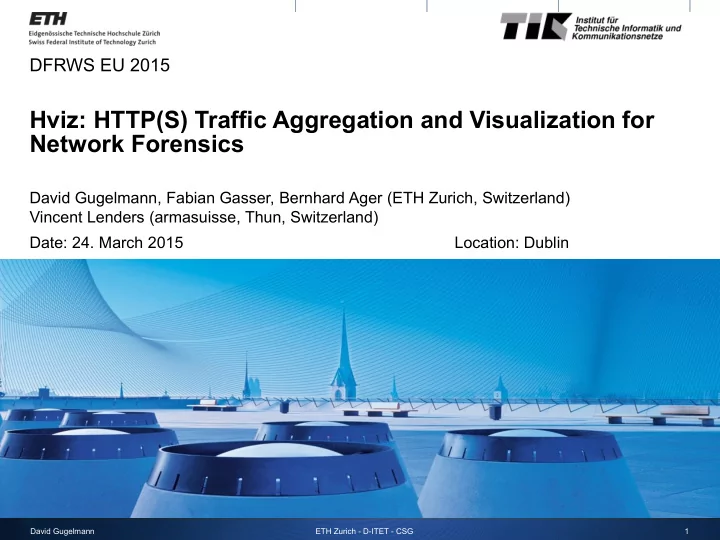

DFRWS EU 2015 Hviz: HTTP(S) Traffic Aggregation and Visualization for Network Forensics David Gugelmann, Fabian Gasser, Bernhard Ager (ETH Zurich, Switzerland) Vincent Lenders (armasuisse, Thun, Switzerland) Date: 24. March 2015 Location: Dublin David Gugelmann ETH Zurich - D-ITET - CSG 1
INTRODUCTION David Gugelmann ETH Zurich - D-ITET - CSG 2
Motivation and problem statement HTTP(S) traffic is important for digital forensics: Many organizations allow Web browsing Main protocol in corporate networks Used by malware as C&C-channel Nowadays Web sites are quite complex: Loading a single Web site can cause dozens to hundreds of HTTP(S) requests Content is loaded from many different servers Difficult to manually reconstruct, identify and analyze suspicious Web activity David Gugelmann ETH Zurich - D-ITET - CSG 3
Contributions Hviz - HTTP(S) traffic visualizer: Grouping, aggregation and correlation of HTTP events Number of events reduced by nearly a factor of 20 Much easier for an investigator to spot anomalies Interactive graph visualization of HTTP(S) activity of a workstation Represent event timeline Visualize “what a user/malware did” Evaluation using synthetic and real-world HTTP traces David Gugelmann ETH Zurich - D-ITET - CSG 4
DESIGN GOALS AND DATA PROCESSING David Gugelmann ETH Zurich - D-ITET - CSG 5
Design goals I. Visualize the timeline of Web browsing, i.e., which sites a user visited II. Support an investigator to understand why a request happened: Result of regular Web browsing Malware activity … III. Reduce the number of displayed events Allow to quickly grasp the big picture IV. Prevent HTTP activity from getting lost in the shuffle E.g., malware activity should be visible despite the large numbers of requests caused by regular Web browsing David Gugelmann ETH Zurich - D-ITET - CSG 6
Step I: Detecting user clicks Request graph and request classification* * Xie et al., ReSurf, IFIP Head requests represent “big picture” Networking, 2013 Request graph shows how user arrived at a Web page David Gugelmann ETH Zurich - D-ITET - CSG 7
Step II.a: Domain aggregation Aggregate embedded requests to domain events David Gugelmann ETH Zurich - D-ITET - CSG 8
Step II.b: FIM aggregation Aggregate domain events using frequent itemset mining (FIM) David Gugelmann ETH Zurich - D-ITET - CSG 9
Step II.b: FIM aggregation Aggregate domain events using frequent itemset mining (FIM) Advantages of aggregation over only displaying head events: Requests that are not related to Web browsing (e.g. malware) are visible Easier to identify and handle misclassified nodes Attackers could intentionally cause misclassifications David Gugelmann ETH Zurich - D-ITET - CSG 10
Step III: Filtering based on correlation Fade out navigation paths that are common to many computers Focus on a workstation’s singular traffic David Gugelmann ETH Zurich - D-ITET - CSG 11
IMPLEMENTATION David Gugelmann ETH Zurich - D-ITET - CSG 12
Implementation Backend processing Bro IDS to parse libpcap files HTTP activity Mitmproxy scripting API for mitmdump logs HTTP and HTTPS activity Python program NetworkX PyFIM (Frequent Item Set Mining for Python) Frontend Running in Web browser 3D.js David Gugelmann ETH Zurich - D-ITET - CSG 13
David Gugelmann ETH Zurich - D-ITET - CSG 14
EVALUATION David Gugelmann ETH Zurich - D-ITET - CSG 15
Evaluation – Detecting user clicks Evaluation dataset: automated Web browsing on top 300 Alexa sites Parameters improved over original ReSurf algorithm David Gugelmann ETH Zurich - D-ITET - CSG 16
Evaluation – Detecting user clicks Evaluation dataset: automated Web browsing on top 300 Alexa sites Parameters improved over original ReSurf algorithm David Gugelmann ETH Zurich - D-ITET - CSG 17
Evaluation – Aggregation and filtering Evaluation dataset: HTTP traffic from a university network, 24h, 1.8k clients, 5.7M requests Event reduction factors: Domain and FIM grouping: 7.5 Popularity-filter (threshold 10/1.8k): 2.9 Overall reduction factor: 19 David Gugelmann ETH Zurich - D-ITET - CSG 18
USAGE SCENARIOS David Gugelmann ETH Zurich - D-ITET - CSG 19
Zeus malware activity during regular Web browsing Zeus activity David Gugelmann ETH Zurich - D-ITET - CSG 20
David Gugelmann ETH Zurich - D-ITET - CSG 21
Data exfiltration Obfuscated upload (less than 2 MB) David Gugelmann ETH Zurich - D-ITET - CSG 22
DFRWS 2009 Challenge Part of DFRWS 2009 forensics challenge: Illegal Mardi Gras images have been shared A suspect denies being responsible for any shared images Hviz shows at a glance that corresponding Web pages have been searched for and accessed (which does not proof that the suspect indeed shared these images, but it is an indication that the system should be analyzed) David Gugelmann ETH Zurich - D-ITET - CSG 23
SUMMARY David Gugelmann ETH Zurich - D-ITET - CSG 24
Summary Hviz visualizes Web browsing activity in a graph: Number of active events reduced by a factor of 19 by grouping, aggregation and correlation An investigator can interactively filter and explore Web activity: Understand the “big picture” Zeus malware activity and obfuscated uploads as small as a few MB clearly stand out Live demonstration: http://hviz.gugelmann.com David Gugelmann ETH Zurich - D-ITET - CSG 25
Recommend
More recommend